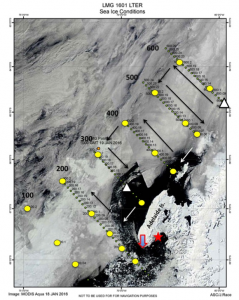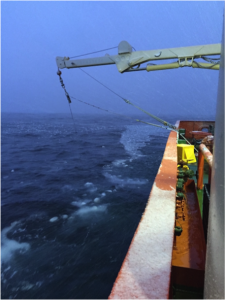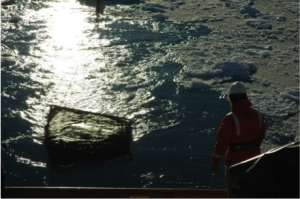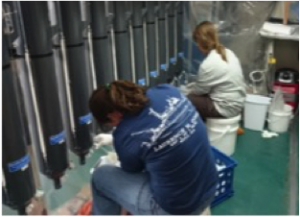
MODIS Terra sea ice image showing western Antarctic Peninsula region, PAL hydrographic stations (yellow circles) and cruise survey region. Black areas are open water. Black arrows show direction of travel. Triangles: physical oceanography moorings. Star: Rothera Base. Red arrow: Avian Island. Image constructed by ET Julian Race.
February 11th, 2016
By: Carly Moreno
The big story this week is sea ice. As we traverse the grid, we’re encountering huge amounts of it. The coverage is so thick in some places the ship has to decrease its speed from 12 knots to 2 knots. Transit times that would normally take 5 hours now take as much as 12 hours. This is unprecedented in the last 15 years of the LTER cruises. Even so, we have managed to occupy all of our hydrographic stations (yellow dots), along the 600 to 200 lines (Figure 1). We will not be able to sample the 100 to -100 lines this year because of the thick ice.
Most of the science on the ship can still being done, just at a slower pace. In some cases, the groups on the ship can’t deploy their equipment. The large zooplankton net tows can’t be deployed because the ice closes around the stern of the ship too quickly as we transit (Figure 2). The towfish, which I use for my own experiments to collect water, also can’t be deployed in ice. The towfish is a line that extends off the knuckle crane on the starboard aft side of the boat (Figure 3). Trace metal clean tubing is attached to the line and water that hasn’t come into contact with the ship is pumped to the trace metal clean lab space. If the towfish can’t be deployed because of the ice conditions, then the Fitzsimmons group helps me deploy their trace metal CTD/rosette, which has minimal metal parts to reduce trace metal contamination.
The Fitzsimmons group aims to determine the sources, sinks, and processes controlling the distribution of micronutrients (Fe, Zn, Cu, Cd, and Ni) and anthropogenic (Pb) trace metals along the WAP. They are also trying to determine to what extent different forms of Fe control phytoplankton production along the WAP from high-iron coastal areas to iron-limited, offshore waters. The group is led by Jess Fitzsimmons, an assistant professor at Texas A&M, her graduate student, and her collaborator at UBC, Amber Annett, who is studying radium inputs from bottom sediments along mid-shelf stations. Last year they lost their trace metal CTD/rosette and had to use the towfish to collect surface samples. This year, it’s the opposite; they mainly use the CTD to sample deeper in the water column, but can’t use the towfish to collect their underway samples. They lack surface grid coverage they had in previous years, but overall, it’s an improvement because they’ll be able to assess the significance of off-shelf metal transport on Southern Ocean metal distribution and primary production.

Trace metal towfish deployment near PAL station 200.000 on Jan 29, 2016. We were travelling parallel to the ice edge and new ice was forming.
Another objective of theirs is to sample the glacial meltwater at Palmer Station for trace metal concentration analysis. They hypothesize that glacial meltwater streams could be a temporally variable but important source of metal including Fe to local phytoplankton communities in near shore regions. Mike Brown, a PhD student with the Schofield group, will take weekly samples of the glacier while he lives at Palmer Station for 3 months.
I’m extremely grateful to Jess Fitzsimmons for her guidance and support while on this cruise. Jess’s knowledge, experience, and generosity while helping me with sample collection, either with the trace metal towfish or CTD, went above and beyond my expectations. Jess and her team were very supportive and my experiments would not have been possible without her. Thank you Jess!



University Operator: (919) 962-2211 | © 2024 The University of North Carolina at Chapel Hill |